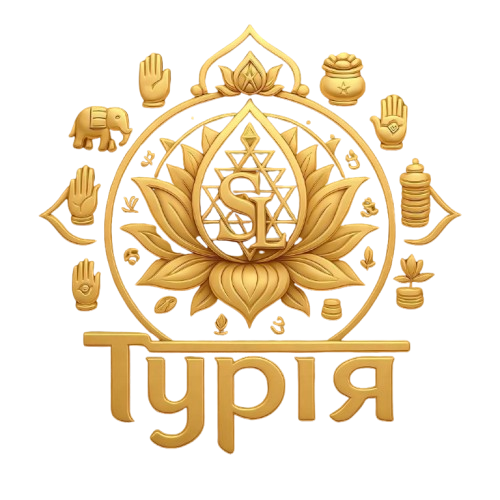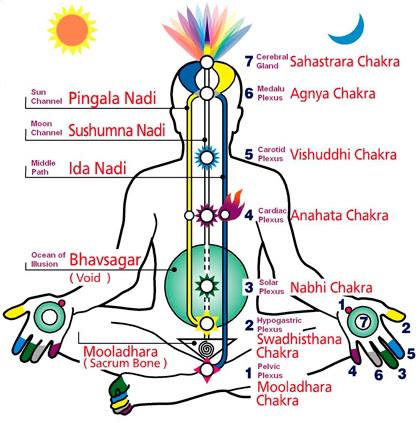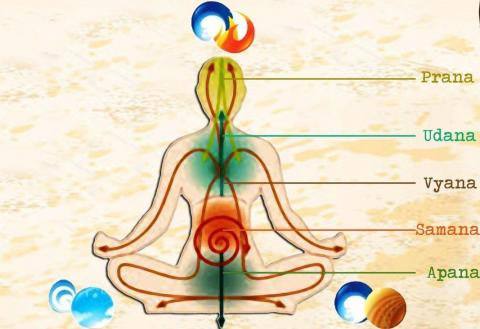Pranayama
Prana is the total energy of the universe.
It is the sum of all forces hidden in a person and surrounding him. Heat, light, electricity, magnetism are manifestations of prana. All physical forces, all energy and prana come from the common source, Atman.
All physical and mental forces are prana.
This power acts on all planes of being, from the lowest to the highest. Everything that moves, functions, lives is an expression or manifestation of prana. Akasha, or ether, is also a manifestation of prana. Prana is connected with the mind, through the mind with the will, through the will with the individual soul, and through the soul with the Supreme Being.
If you can control the small waves of prana that pass through the mind, you know the secret of controlling the general prana.
A yogi who has mastered this art is not afraid of any force, as he controls all the forces of this world. What is called personality strength is only the natural ability of a person to control his prana. Some people are more lucky, influential and attractive than others. This is due to the power of their prana. They are constantly manipulating prana, but of course unconsciously. A yogi uses it consciously, by effort of will. Some accidentally find unconscious control over prana and use it for nefarious purposes.
The work of prana is manifested in the contractions of the pericardium, when the heart pumps blood through the arteries, in each inhalation and exhalation, in the digestion of food, in the excretion of urine and fecal masses, in the production of semen, milk juice, food gruel, gastric juice, bile, intestinal fluids and salivation, in raising and lowering the eyelids. It operates when we walk, play, jump rope, think, argue, feel and desire. Prana is the connection between the physical and the astral body. When the thin thread of prana breaks, the astral body leaves the physical body. Death is coming. Prana, which was active in the physical body, returns to the astral.
During cosmic pralaya, prana is in a subtle, motionless, indistinct state. When the vibrations arise, the prana begins to move, begins to interact with the akasha and gives rise to various forms. The macrocosm (brahmanda) and the microcosm (pindanda) are combinations of prana (energy) and akasha (matter). Prana moves locomotives, steamships and airplanes, moves the air in the lungs, is the very life of this breath. Now I think you have understood the term prana, of which you had only a vague idea at first.
By controlling the breath, you effectively control all kinds of movements and nervous currents of the body. Breath and Prana Control allows you to easily and quickly control and develop your body, mind and soul. With the help of prana-yama, you can control your destiny and character, consciously bring your individual life into harmony with the cosmic one.
Breathing, controlled by thought under the control of the will, is an enlivening, regenerating force that can be consciously used for self-development, treatment of complex diseases, and many other beneficial purposes.
- Full yogic breathing.They begin to inhale air through the nose, then release it into the throat (ujjayi), moving to the chest and smoothly into the stomach.To fill the entire volume of the lungs, the air is immediately directed into the abdomen, then into the lungs, and then into the collarbone.Exhalation occurs in the reverse order: clavicle – chest – abdomen.This technique is called dirga pranayama, or three-beat breathing.It combines in one cycle all types of breathing available to a person.
- Kapalabhati.A breathing technique that cleanses the body of toxins.The technique is based on soft inhalation and sharp exhalation through the stomach with delays.Pauses are necessary to compensate for excess oxygen in the brain.The technique is used in the morning, on an empty stomach.The blood is purified, the brain wakes up.
- Bhastrika, or “blacksmith’s fur.”This technique is based on intense inhalation and exhalation.Inhalation is performed through the diaphragm, exhalation through the abdomen.Pranayama promotes detoxification, ignites the internal fire (according to Ayurveda, it is digestion), helps to warm the body, and improves the internal organs of a person.
- Surya bhedana.It is based on breathing through the right energy channel (right nostril).After closing the left nostril, inhale, after a pause, exhale through the left.Such exercises energize, tone, stimulate activity.
- Chandra Bhedana.Inhale through the left nostril.Lunar energy circulates in the left channel, it calms and cools the body.It is best to practice chandra bhedan before going to sleep or to relax after a lot of stress or overexertion.
- Nadi shodhana.The purification technique combined Surya and Chandra Bhedan.It is used to balance the energy of the sun and the moon.It is performed as follows: inhalation of the left – exhalation of the right – inhalation of the right – exhalation of the left.One of the varieties is the anuloma fracture: there is a pause after each inhalation and exhalation.
- SahajaA fairly new direction, formed in the 70s of the XIX century.Breathing exercises performed during meditation.
- strengthen the cardiovascular system and central nervous system;
- improve the work of the gastrointestinal tract;
- cleanse the blood of toxins;
- strengthen respiratory muscles and lungs, increase their volume.
- there are acute or chronic diseases of the cardiovascular system;
- Do you have high blood pressure;
- there are such diseases as thrombosis, leukemia, hemophilia;
- diagnosed severe TBI;
- detachment of the retina, inflammation of the middle ear or diaphragm defect is observed.
- Food.As we chew our food, we receive life-giving energy through our tongue.Not the stomach, as everyone is accustomed to think, but the tongue.Yes, the stomach is involved in food processing, digesting food, we get the necessary substances and trace elements for our body.
- But subtle energy can be obtained only with the help of speech.Language helps us taste food.If you want to get as much prana as possible from food, you need to chew food for a long time and carefully.In today’s world, due to haste, many simply swallow food in a hurry and thus deprive themselves of the energy of the subtle world.Another important condition is that the livelier the food, the more energy-rich it is.
- Through the skin.The sunlight that our skin absorbs can also endow us with prana.
- With the help of air.Correct breathing through the nose (not through the mouth) can fill the body with subtle energy.The nose is an important organ, where nerve receptors communicate with the spinal cord and interact to perform the functioning of the organs.If you breathe correctly through your nose, you can be filled with vital energy.It is especially important to breathe in natural air: the smell of flowers, grasses, coniferous or deciduous trees, the smell of meadows and forests fills a person with energy.
- Through mind and meditation.With the help of the mind, we direct and control the life-giving energy in our body.Only in a conscious state can one be filled with prana.If you breathe quickly without awareness, then energy flows simply will not happen.By meditating, you can be filled with the energy of the subtle world
- Problems with the respiratory system;
- Numbness of legs and arms;
- Hypochondria;
- Weak blood circulation;
- Obsession
- Practices and techniques can be performed 3 hours after eating.
- You can’t slouch. All exercises are performed only with a straight back.
- You can’t talk. There should be silence during practices.
- Do not jump from exercise to exercise. Gradually adapt your body and breathing to the techniques.
- Classes take place only in a calm mode.
- You can’t be afraid. There is no fear.
- Vacation. The main rule is to get enough sleep and adjust the sleep mode. It is important to sleep between 10 pm and 2 am.
- Fresh “living” food. Eat more fruits, vegetables, seeds, juices. Reduce the number of ready-made store products.
- Get rid of negative emotions. Draw, meditate, dance.
- Walking in the fresh air is a must, especially in the forest, parks, and mountains.
- Charging or sports. Physical activity increases prana.
- Drink herbal tea. Mix freshly picked herbs from meadows and fields, brew tea and drink on an empty stomach with honey.


 Українська
Українська Русский
Русский

